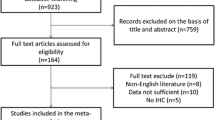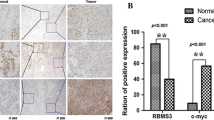Abstract
Nasopharyngeal carcinoma (NPC) is a malignant disease derived from nasopharyngeal epithelial cells that have a higher tendency for invasion and metastasis to the cervical lymph nodes than other head–neck malignancies. NPC patients with the same stages often show different progressions and prognoses. This suggests that clinical stages are not sufficient to predict progressivity, so biomarkers are required to provide better progression predictions. Some literature shows that the development and progression of NPC is a complex mechanism involving various components of signal paths, it plays a role in regulating the process of proliferation, angiogenesis and apoptosis. One of the most studied is β-catenin protein that is a key component of the canonical Wnt signal pathway. The β-catenin protein is reported to have roles in increasing the proliferative pathway of c-Myc and cyclin D1, increasing the expression of IL-8 proangiogenesis factor, decreasing expression of RASSF1A tumor suppressor and inhibiting apoptosis through the barriers of caspace-9 activity. To determine the association of β-catenin expression and staging in nasopharyngeal carcinoma patients. The research design used was analytic observational research with cross sectional approach. Samples were enrolled using consecutive sampling. The β-catenin expression was examined from the NPC tissue paraffin block with the immunohistochemical cracking technique, using an anti-β-catenin rabbit polyclonal antibody from Boster Biotechnology, California, USA. The β-catenin expression was assessed visually using a binocular light microscope and a scoring method according to the Allred scale index by an Anatomical Pathology consultant. Statistical analysis was performed using Spearman’s test to determine the association between β-catenin expression and staging in NPC patients. The significance level was α = 0.05. The study was conducted from May to December 2015 at Otolaryngology Unit of Dr. Soetomo General Soetomo, Surabaya. There were 40 patients who fulfilled the inclusion criteria. Spearman test results obtained p value = 0.060. The correlation of β-catenin expression with staging in NPC patients was found to be non-significant (p > 0.05). There was no correlation between β-catenin expression and staging in NPC patients.

Similar content being viewed by others
References
Luo W, Fang W, Li S, Yao K (2012) Aberrant expression of nuclear vimentin and related epithelial–mesenchymal transition markers in nasopharyngeal carcinoma. Int J Cancer 10:1863–1873
Wey WIKD (2010) Current management strategy of nasopharyngeal carcinoma. Clin Exp Otorhinolaryngol 1:1–12
Chou J, Lin Y, Kim J, You L, Xu Z, He B et al (2008) Nasopharyngeal carcinoma—review of the molecular mechanism of tumorigenesis. Head Neck 30(7):946–963
Wang FL, Xiang G, Yuan TZ, Cao SM, Roo HL, Hou JH et al (2009) Expression and clinical significance of Wnt-1 and β-catenin in nasopharyngeal carcinoma. Chin J Cancer 8(1):72–79
Shi W, Bastianutto C, Li A, Ordonez BP, Ng R, Chow KY (2006) Multiple dysregulated pathways in nasopharyngeal carcinoma revealed by gene expression profilling. Int J Cancer 119:2467–2475
Chen C, Yi W, Gao J, Li XH, Shen LJ, Li BF et al (2014) Alternate endpoints to the 5-year overall survival and locoregional control for nasopharyngeal carcinoma: a retrospective analysis of 2,450 patients. Mol Clin Oncol 2:385–392
Notopuro H, Kentjono W, Handajani R, Notopuro F (2008) Detection of cytokeratin 19 mRNA in blood as an early marker of micrometastatic tumor cells of nasopharyngeal carcinoma patients in surabaya. Folia Medica Indones 44(2):76–81
Moussa SAB, Guemira F, Buisine MP (2014) Detection of circulating tumor cells in the peripheral blood of nasopharyngeal carcinoma patients by nested reverse transcriptase polymerase assay for cytokeratin 19 mRNA. Afr J Biotechnol 13(3):378–384
Santoro A, Pannone G, Papagerakis S, McGuff HS, Cafarelli B, Lepore S et al (2014) Beta-catenin and epithelial tumors: a study based on 374 oropharyngeal cancer. Biomed Res Int 64:1–13
Xu L, Jiang Y, Zheng J, Xie G, Li J, Shi L et al (2013) Aberrant expression of β-catenin and E-cadherin is correlated with poor prognosis of nasopharyngeal cancer. Hum Pathol 44(7):1357–1364
Zheng H, Li L, Hu D, Deng X, Cao Y (2007) Role of Epstein–Barr virus encoded latent membrane protein 1 in the carcinogenesis of nasopharyngeal carcinoma. Cell Mol Immunol 4(3):185–196
Brat DJ, Bellail AC, Van Meir EG (2005) The role of interleukin-8 and its receptors in gliomagenesis and tumoral angiogenesis. Neuro Oncol 7(2):122–133
Li XJ, Peng L, Shan JY, Lu WH, Zhang JX, Chen S et al (2012) As an independent unfavorable prognostic factor, IL-8 promotes metastatic of nasopharyngeal carcinoma through induction of epithelial–mesenchimal transition and activation of AKT signalling. Carcinogenesis 33:1302–1309
Yip WK, Seow H (2012) Activation of phosphatidylinositol 3-kinase/Akt signalling bu EGF downregulates membranous E-cadherin and β-catenin and enhances invasion in nasopharygeal carcinoma cell. Cancer Lett 318:162–172
Lo PHY, Xie D, Chan KC, Xu FP, Kuzmin I, Lerman MI et al (2007) Reduced expression of RASSF1A in esophageal and nasopharyngeal carcinomas significantly correlates with tumor stage. Cancer Lett 257:199–205
Rosenthal EL, Matrisian L (2006) Matrix metalloproteinases in head and neck cancer. Head Neck 28:639–648
Chen S, Guttridge C, You Z, Zhang Z, Fribley A, Mayo MW et al (2001) Wnt-1 signaling inhibits apoptosis by activating β-catenin/T cell factor-mediated transcription. J Cell Biol 152(1):87–96
Bruun J, Kolberg M, Nesland JM, Svindland A, Nesbakken A, Lothe RA (2014) Prognostic significance of β-catenin, E-cadherin, and SOX9 in colorectal cancer: result from a large population-representative series. Front Oncol 4(118):1–16
Pfister DG, Ang KK, Brizel DM, Burtness BA, Cmelak AJ, Colevas AD et al (2011) Head and neck cancers. J Nat Compr Cancer Netw 9(6):596–650
Galera-Ruiz H, Ríos M, Campora RG, de Miguel M, Carmona MI, Moreno AM et al (2011) The cadherin–catenin complex in nasopharyngeal carcinoma. Eur Arch Otorhinolaryngol 268:1335–1341
Osterheld MC, Bian Y, Bosman FT, Benhattar J, Fontolliet C (2012) Beta-catenin expression and its association with prognostic factors in adenocarcinoma developed in Barrett esophagus. Am J Clin Pathol 117:451–456
Wu J, Lv Q, Qing Lv, Jie He, Zhang H, Mei X, Cui K et al (2014) MicroRNA-188 supresses G1/S transition by targeting multiple cyclin/CDK complexes. Cell Commun Signal 12(66):1–13
Oppenheim JJ, Feldman M, Durum SK, Hirano T, Vilcek J, Nicola NA (2000) Cytokine reference: a compendium of cytokines and other mediators of host defence, 1 edn. Academic Press, London
Feng X, Ching B, Chen WN (2012) EBV up-regulates cytochrome c through VDAC1 regulations and decrease the release of cytoplasmic Ca2 + in the NPC cell line. Cell Biol Int 36:733–738
Lo AKF, Lo K, Tsao SW, Wong HL, Hui JWY, To KF et al (2006) Epstein–Barr virus infection alters cellular signal cascades in human nasopharyngeal epithelial cell. Neoplasia 8(3):173–180
Yoshizaki T, Horikawa T, Ren QC, Wakisaka N, Takeshita H, Sheen TS et al (2001) Induction of interleukin-8 by Epstein–Barr virus latent membran protein-1 and its correlation to angiogenesis in nasopharyngeal carcinoma. Clin Cancer Res 7:1946–1951
Man C, Rosa J, Lee LTO, Chow BKC, Lo KW et al (2007) Latent membran protein 1 supresses RASSF1A expression, disrupts microtubule structures and induces chromosomal aberration in human epithelial cells. Oncogene 26:3069–3080
Jiang H, Fan D, Zhou G, Li X, Deng H (2010) Phosphatidylinositol 3-kinase inhibitor (LY294002) induces apoptosis of human nasopharyngeal carcinoma in vitro and in vivo. J Exp Clin Cancer Res 29(34):1–7
Hua Z, Lv Q, We Y, Wong CK, Cai G, Gu D et al (2006) MiRNA-directed regulation of VEGF and other angiogenic factors under hypoxia. PLoS ONE 1:116–127
Author information
Authors and Affiliations
Corresponding author
Rights and permissions
About this article
Cite this article
Amelia, F.I., Yusuf, M. & Artono Correlation Between β-Catenin Expression and Staging in Nasopharyngeal Carcinoma Patients. Indian J Otolaryngol Head Neck Surg 71 (Suppl 1), 384–389 (2019). https://doi.org/10.1007/s12070-018-1321-8
Received:
Accepted:
Published:
Issue Date:
DOI: https://doi.org/10.1007/s12070-018-1321-8




